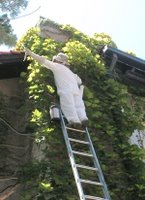At this morning's "Primp Your Blog" session at
BlogHer, presenter Skye Kilean spoke about ways to make your blog more accessible to users with disabilities. Kilean writes the
Flooded Lizard Kingdom blog. She had some good info, especially for those of us in education.
Kilean described her presentation as "how we add 'wheelchair ramps' to our blogs." Here are some of her suggestions:
Using text, links, colors: avoid uninformative links (such as click here, click on this, etc.). It's better to use a bigger click target (that is, more words, especially descriptive words such as "story on endangered bats"). Links that automatically open a new window can be disconcerting to visually impaired users. Make sure links change color when once they've been clicked so people can keep track of what they've already viewed; also remember some people are colorblind so use other cues, like boldface not just color change, to indicate visited links.
Images: Label photos so visually impaired people get information on key images they can't see. Use brief informative text to label images; remember, screenreaders read the "alt" label, but don't always read the title info. To make a screen reader skip a non-vital image, use alt=_ (leaving a space "_" tells the screenreader to skip this image). Blogger.com includes an "alt" area to describe pictures; edit them in the "edit html" tab.
Spam: Anti-spam measures to stop spam comments can make things difficult for people with visual impairments. Blogger has recently added an audio option for this.
Template-related stuff: Put sidebar on right so visually impaired people get your blog content read to them first, not your sidebar info. Put text size in percentages (Blogger already does this), not specific point sizes, for those who need larger text sizes.
For further information, Kilean recommends
Bulletproof Web Design, a book by
Dan Cederholm. She has also posted
this information and more on her blog, with links to good and bad examples and additional resources.
 During a podcasting "how to" session led by Susan Kitchens, who blogs at 2020Hindsight.org, I recorded a short interview with San Jose Mercury News reporter Elise Ackerman.
During a podcasting "how to" session led by Susan Kitchens, who blogs at 2020Hindsight.org, I recorded a short interview with San Jose Mercury News reporter Elise Ackerman.


